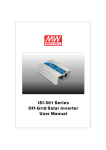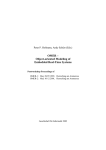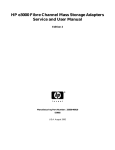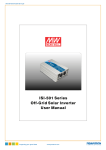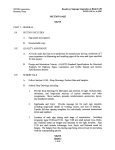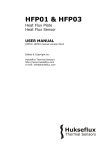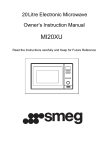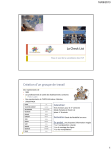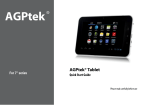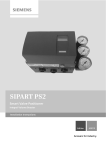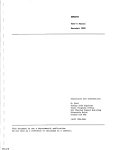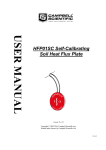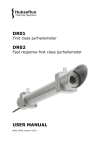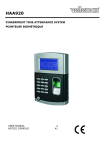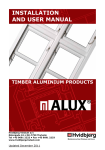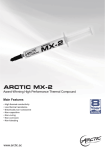Download SBG01 Manual v1208 - Hukseflux - Thermal Sensors
Transcript
SBG01 Water cooled heat flux sensor according to Schmidt Boelter USER MANUAL sbg01 manual v1208 SB G0 1 m a nu a l v 1 20 8 2/42 Contents Contents List of symbols Introduction 1. Gene ral Theory 1.1 General heat flux sensor theory 1.2 Considerations when using a heat flux sensor 1.3 Cooling water supply 1.4 Using uncooled sensors 2. Error sources 2.1 Non-linearity 2.2 Errors due to convection 2.3 Radiation balance 3. Application in F ire testing 3.1 Ignitability test ISO 4557 3.2 Spread of flame test: ISO 5658 3.3 Heat release, smoke production and mass loss: ISO 5660 and ISO 17554 4. Specifications 5. Short user guide 6. Putting SBG01 into operation 7. Installation of SBG01 8. Maintenance of SBG01 8.1 Recoating SBG01 9. Re quireme nts for amplification/ data ac quisition 10. Electrical connection of SBG01 11. Appendices 11.1 Appendix on cable extension for SBG01 11.2 Appendix on trouble shooting 11.3 Appendix on heat flux sensor calibration 11.4 Appendix on typical and allowable levels 11.5 Special designs: conical receivers 11.6 Special designs: air purging /avoiding condensation 11.7 Special designs: optical filtering 11.8 Gardon versus Schmidt Boelter 11.9 Appendix on (future) standard ISO TS 14934 Fire tests-calibration of heat flux meters 11.10 Appendix on def ining new sensors 11.11 Appendix on heat flux versus the view factor 11.12 CE declaration of conformity SB G0 1 m a nu a l v 1 20 8 3 4 5 8 8 8 10 11 13 13 13 15 17 17 17 18 19 21 22 23 24 24 26 27 29 29 29 30 32 33 34 35 36 37 39 39 40 3/42 List of symbols Heat flux Voltage output SBG01 sensitivity Time Surface area Electrical resistance Temperature Temperature dependence Flow Heat transfer coefficient Wind speed V Es en t A Re T TD F Ctr Vwind W m- 2 V V/Wm- 2 s m2 K %/K m3 /s W/(m2 K) m/s Subscripts Property of the sensor Property of convective source Property during calibration, at full scale Property radiant source Property at the soil surface Incoming Outgoing True, as opposed to measured SB G0 1 m a nu a l v 1 20 8 sen conv cal rad surf in out true 4/42 Introduction SBG01 is a water-cooled heat flux sensor. The ISO standards call this heat flux meter. Its main purpose is the study of reaction to fire and fire resistance, applied for instance in flammability tests and smoke chamber tests. SBG01 measurements are in accordanc e with various ASTM and ISO standards. SBG01 is on the market since 2008, and has rapidly become the sensor of choice for fire testing laboratories. SBG01 serves to measure the heat flux of fire and flames in the range up to 200 kW/m2 . Heat flux sensors of this type are originally designed to work in an environment that is dominated by radiation (so above 50 kW/m2 ). Application in environments lower irradiance levels and with much convection should be done with care. Working completely passive, using a thermopile sensor, SBG01 generates an output voltage proportional to the incoming flux. The sensor is water cooled. There are 6 types of SBG01, with different working range, sensitivity and response time. Figure 1 SBG01 Heat flux sensor / heat flux meter SB G0 1 m a nu a l v 1 20 8 5/42 Comparing to traditional Gardon and Schmidt Boelter gauges, SBG01 has several advantages: - water cooling tubes with increased robustness increased scratch resistance of absorber paint (slightly lowered surface) practical protection cap Figure 2 protecting the sensing surface is convenient with the practical protection cap. Hukseflux provides traceable calibration, our secondary standard is calibrated at the Statens Provningsanstalt (SP), Sweden and by definition is thereby also traceable to NIST. Hukseflux is not a “certified lab”; if required, the user is responsible to maintain certified traceability. The actual sensor in SBG01 is a thermopile. Working completely passive, SBG01 generates a small output voltage proportional to the local heat flux. This flux can be radiative as well as convective. Using SBG01 is easy. For readout one only needs an accurate voltmeter that works in the millivolt range. To calculate the heat flux, the voltage must be divided by the sensitivity; a constant that is supplied with each individual instrument. Cooling can be done by connecting the sensor to tap water. SB G0 1 m a nu a l v 1 20 8 6/42 Figure 3 SBG01 from top to bottom: 3D view, side view, top view, Dimensions in mm. Coated sensing element (1), water cooling tube (2), Outer diameter tube: 4,2 mm, signal cable (3). Standard cable length is 2 m. SB G0 1 m a nu a l v 1 20 8 7/42 1. General Theory 1.1 General heat flux sensor theory A heat flux meter is a measurement instrument with which the heat flux from the environment to the sensor at the location (and in the plane of) the absorber can be measured. As pointed out in the introduction, in most cases the main contribution to this heat flux will be the irradiance as received from the so-called source. In a normal situation the field of view of the sensor is assumed to be 180°, and the surface is assumed to behave as a perfect blackbody, both regarding the spectral characteristics and the directional response. As in most heat flux sensors, the actual sensor in SBG01 is a thermopile. This thermopile measures the differential temperature across a small plastic body inside SBG01. Working completely passive, it generates a small output voltage that is proportional to the differential temperature that powers the heat flux travelling through it. (Heat flux is proportional to the differential temperature divided by the local thermal conductivity of the heat flux sensor). This sensor is coated black, in order to have a flat spectral sensitivity. It is silently assumed that sensitivity does not depend on wavelength over the spectral range of the radiating sources, commonly analysed. Also deviations from the ideal directional response characteristics can normally be neglected. The sensor is mounted on a heat sink, which is water-cooled. The total assembly is able to cope with high radiation levels; up to 200 kW/m2 . Assuming that the heat flux is steady, that the thermal conductivity of the body is constant and that the sensor has negligible influence on the thermal flow pattern, the signal of SBG01 is proportional to the local heat flux in Watt per square meter. Using SBG01 is easy. For readout one only needs an accurate voltmeter that works in the millivolt range. To convert the measured voltage V s en to a heat flux , the voltage must be divided by the sensitivity Es en, a constant that is supplied wit h each individual sensor. = Vs en / Es en 1.1.1 NOTE: see also paragraph 2.3 for lower flux levels. SBG01 complies with the CE directives. 1.2 Considerations when using a heat flux sensor SBG01 sensors are used for many purposes; the most common application is in various types of "fire testing" (or reaction-to-fire testing). These tests involve spread of fire, flammability testing, smoke release and many other aspects related to fire. SB G0 1 m a nu a l v 1 20 8 8/42 It is important to understand the limitations of what Hukseflux does and does not supply. This is particularly relevant to customers working in (fire) testing, where testing is used as part of certification and subject to legal liability. The main conclusions are that: The user must always let his reference sensor or reference sensors be calibrated at a "reference institute". At present these are: NIST, SP and LNE. Working along the (future) ISO standards, the user must buy at least 4 sensors of which 3 are “secondary standard”, and meant as internal references, and one to work with (“working standard”). An SBG01 heat flux meter could be calibrated as secondary standard. Below a summary of considerations. 1 The SBG01 sensor specifications are such that in principle the sensor may be used for certain types of fire testing, flammability testing etc. However, for performing a test "by the book" it is not sufficient to have a sensor with the right specifications. The calibration of the sensor, as well as the procedures followed by the user for quality assurance (to verify stable behaviour) need to be implemented according to the applicable standards. It is essential to realise that the measurement uncertainty is a function of: Sensor properties Calibration traceability of and quality assurance of the local reference at the customer Quality assurance of calibration of SBG field sensors or "working standards" in day to day measurements Measurement-related errors, for instance caused by convection 2 The calibration as performed at Hukseflux during manufacturing (factory calibration) of the SBG sensors typically is NOT sufficient to be used immediately in certified fire related experiments. The formal status of the c alibration is “against a working standard” according to the procedure ISO 14934-3. Also when working within a certified laboratory, for instance according to ISO 17025, or even according to ISO 9000, the customer will have to send its calibration references to a certified calibration lab (this may be NIST in the USA, LNF in France or SP in Sweden). Hukseflux is NOT formally certified to carry out calibrations. Hukseflux does believe that its calibrations are within the specified accuracy, but from a formal standardisation point of view this is not sufficient. Because Hukseflux is not a certified laboratory, SBG01 sensors as delivered by Hukseflux are not 'secondary standard', nor 'working standard' according to ISO TS 14934-4. As a source for primary calibration (resulting in a secondary standard instrument), Hukseflux recommends SP in Sweden. As an alternative source for calibration, NIST in the USA can be contacted. 3. If the user wants to follow the (future) ISO TS 14934-4 standard (for details see appendix), the user should purchase at least 4 (four!) sensors: 3 (three) to be calibrated by a laboratory as 'secondary standard' and 1 (one) to be used as 'working standard'. See section 'ISO TS 14934-4 Fire tests-calibration of heat flux meters' for additional information. SB G0 1 m a nu a l v 1 20 8 9/42 1.3 Cooling water supply For normal applications in fire research, the standard 3 bars of tap water supply are sufficient for operating heat flux meters. In case of extremely high fluxes, which are not relevant to SBG01 (above 2500 kW/m2 ), additional pressure may be necessary. As water has a very high heat capacity; for 1 inch (25.4 mm) diameter sensors a water supply of 30 l/hr or 0.01 l/s is sufficient to carry away all the generated heat with a temperature rise of less than 10 degrees C. (safety factor of 4). If it is impractical to use tap water, for passive closed circuit cooling of SBG01, Hukseflux successfully employed the Zalman reserator. Closed circuit water cooling with convective heat exchanger. Figure 1.3.1 close up of the convective cooling of the reserator SB G0 1 m a nu a l v 1 20 8 10/42 Figure 1.3.2 Julabo F12 An alternative possibility is to use a large vessel filled with water or coolers such as supplied by the Julabo company, such as model F12 refrigerated / heated circulator 1.4 Using uncooled sensors In some cases a non-cooled SBG01 may be used (so not connected to the water supply). This can be considered if: 1. the measurement is so short that SBG01 cannot significantly heat up; typically this requirement is fulfilled in case the time is less than 1 second; 2. the flux is so low that SBG01 cannot significantly heat up; typically this requirement is fulfilled in case fluxes are lower than 1 kW/m2 . In this case it is relevant to consider that SBG01 is very inaccurate anyway in low flux measurements because typically the convective flux starts playing a significant role. (please note that in general Hukseflux discourage measurements with SBG01 below 10 kW/m2 because of low expectations of the measurement accuracy) SB G0 1 m a nu a l v 1 20 8 11/42 3. there is a large heat sink (for instance a block of aluminium or melting stearin) attached to SBG01 4. any combination of 1, 2 and 3. In all cases it is recommended: 5. to perform an experiment with similar temperature rise versus time, but no heat flux to the sensor, to get an order of magnitude of the offset signal that is produced by the SBG01 just due to the thermal shock (please note that a thermal shock -rise of temperature- of the housing goes together with a heat flux to the sensor, and thus a negative offset.) 6. to see that temperature of the sensor remains below 70 degrees C (the limit of materials is 150 degrees C, but the centre of the sensor get hotter in case of incoming heat flux) 7. to minimize the exposed surfaces by adding heat shields and insulation 8. to try and calculate temperature rise before experimenting; the SBG01 weight is around 110 grams of metal, so it has a heat capacity of 44J/K (heat capacity is around 400J/(kgK). 9. In any case add as much mass as possible and shield the sensor from any radiation not necessary for the measurement. Example calculation: at 100 kW/m2 and a surface area of 5/1000 m2 , the incoming energy is 50 W, which results in 1.2 K/s temperature rise. Starting at 20 degrees C, a measurement time of 40 s is feasible. SB G0 1 m a nu a l v 1 20 8 12/42 2. Error sources Measurements with heat flux sensors are subject to errors. The basic calibration is performed at full scale (depending on the type, this is 5, 10, 20, 50, 100 or 200 kW/m2 ). The initial calibration accuracy is +/- 3%. Added to this initial error, the most significant error sources are non-linearity, convection, and the radiation balance 2.1 Non-linearity The SBG01 is calibrated at the full range, however with a minimum of 20 kW/m2 and a maximum at 100 kW/m2 . When measuring at a fraction of the full range, the sensor is expected to have an output V that varies linearly with the heat flux. This is only approximately true. The deviation from ideal behaviour is captured in the so -called nonlinearity. This specification expresses the maximum deviation from ideal behaviour. The non-linearity is expressed in percentage of the full scale heat flux. Non-linearity errors can be quite large. The main conclusion is:If this is possible, heat flux sensors should be used at flux levels higher than 50% of the full scale range. c al = Vs en, c al / Es en, c al 2.1.1 With c al the full scale heat flux, as used during calibration. During a measurement in practice: = Vs en / Es en, c al 2.1.2 or = ( Vs en / Vs en, c al) ) c al 2.1.3 The non-linearity, NL, is expressed as: NL = (true - )/ c al 2.1.4 With true , the true heat flux, and thus true - the measurement error. It should be noted that the non-linearity is allowing for quite large relative error margins at lower flux ranges. For the 200 kW/m2 model, the +/- 2% allows a +/- 4 kW/m2 error. When measuring with the same sensors at 20 kW/m2 , this is an error of +/ - 20%. 2.2 Errors due to convection In most applications, the purpose of the heat flux measurement is to measure radiant energy. Assuming that this is the purpose, it is a problem that heat flux sensors like SBG01 are sensitive both to convection and to radiation. In most cases the errors caused by this, are simply accepted as part of the inaccuracy of the measurement. In order to get some idea of orders of magnitude one can take a look at the following text. The main conclusions are: SB G0 1 m a nu a l v 1 20 8 13/42 1. in an outdoor environment, below 50 kW/m2 it is not realistic to claim accuracies within +/- 15%. (including calibration uncertainty) 2. in fire related experiments one should make sure that either radiat ive fluxes are high or that the convective heat transfer is low (the latter by reducing air temperature or by reducing air speed). A typical fire related indoor experiment should be radiation-dominated. Convective air will create two errors: 1. the convective error: a positive and negative contribution to the heat flux, depending on the difference between air temperature and sensor temperature. Please note that, in case it is the purpose of the experiment to measure the local convective plus radiative flux, t his is not a measurement error. 2. the sensitivity error: the local heat transfer coefficient will vary with air speed, so with air speed the effective sensitivity for radiation will vary. In buildings, under indoor conditions we can expect wind speeds of 1 m/s. Working environments will 90% of the cases have wind speeds below 0.5 m/s. Under outdoor conditions up to 30 m/s can be considered normal, with 90% of the cases below 15m/s. A reasonable approximation of the heat transfer coefficient at moderate wind s peeds is given by: Ctr = 5 + 4 Vwind 2.2.1 With Ctr in W/(m2 K) and in Vwind m/s. In fires, no heat transfer coefficient data are known, however, we are working with a figure of 50 W/(m2 K). As a qualitative experiment we consider several cases; a heat transfer coefficient of 10 and 50 W/(m2 K), three flux levels 10, 50 and 100 kW/m2 , 2 sensor thermal resistances of 1000 and 2000 W/(m2 K), and two air temperatures of 400 and 20 degrees C, all at 10 degrees C sensor body temperature. SB G0 1 m a nu a l v 1 20 8 14/42 Table 2.2.1 convec tion related error estimates in different environments. Convective error is estimated, under the assumption that the purpose is to measure the radiative flux rad, and that measurement of conv is undesired. The sensitivity error is estimated by taking the ratio of the two thermal resistances Ctr and R sen. Rsen Tair Tsen conv CONVECTIVE ERROR SENSITIVITY ERROR kW/m2 W/(m2K) W/(m2K) deg C deg C kW/m2 % % 10 50 2000 20 15 0.5 5% 3% 50 50 2000 20 35 0.5 1% 3% 100 50 2000 20 60 0.5 1% 3% 10 10 2000 20 15 0.1 1% 1% 50 10 2000 20 35 0.1 0% 1% 100 10 2000 20 60 0.1 0% 1% 10 50 1000 20 20 0.5 5% 5% 50 50 1000 20 60 0.5 1% 5% 100 50 1000 20 110 0.5 1% 5% 10 10 1000 20 20 0.1 1% 1% 50 10 1000 20 60 0.1 0% 1% 100 10 1000 20 110 0.1 0% 1% 10 50 2000 400 15 19.5 195% 3% 50 50 2000 400 35 19.5 39% 3% 100 50 2000 400 60 19.5 20% 3% 10 10 2000 400 15 3.9 39% 1% 50 10 2000 400 35 3.9 8% 1% 100 10 2000 400 60 3.9 4% 1% 10 50 1000 400 20 19.5 195% 5% 50 50 1000 400 60 19.5 39% 5% 100 50 1000 400 110 19.5 20% 5% 10 10 1000 400 20 3.9 39% 1% 50 10 1000 400 60 3.9 8% 1% 100 10 1000 400 110 3.9 4% 1% rad 2.3 Ctr Radiation balance Also it should be realized that, calibrating using radiation, the output of a heat flux sensor n fact is a radiation balance SB G0 1 m a nu a l v 1 20 8 15/42 = in - out Where is the heat flux in kW/m2 as measured by the heat flux sensor, in is the incident heat flux in kW/m2 and out is the emitted heat flux in kW/m2 . Taking radiative transport only: 4 in = T s ensor out = T 4 s ource Where is Boltzmann’s constant, 5.67 10- 8 W/m2 K4 , T s ensor is the sensor temperature in K, assuming a blackbody absorber, and T s ource is the source temperature in K, assuming a uniform source. The heat flux out from the absorber of 20 degrees Celsius is around 0,420 kW/m2 . This implies that in calibration where the sources are typically 800 degrees C and higher, (which implies at full view angle, around 75 kW/m2 ) this contribution is usually neglected. In these cases this forms only 0.6% of the total contribution. In case that fluxes of less than 75 kW/m2 are measured with a sensor temperature of approximately 20 degrees, the resulting error will be larger than 0.6%. Concluding: At a level of 10 kW/m2 the error is around 5%, and at lower levels than 10 kW/m2 a correction for out should be made. SB G0 1 m a nu a l v 1 20 8 16/42 3. Application in Fire testing In this chapter examples are given of the application of heat flux meters in standardized test environments for fire testing. The text serves solely as illustrative, and for detailed test procedures, the individual standards should be consulted. If employed according to the directions of the standard, including proper calibration and quality assurance procedures by the user, SBG01 is expected to be suitable for use. Some FAA standards specifically mention the use of Gardon Gauges. See the appendix on Gardon versus Schmidt Boelter. 3.1 Ignitability test ISO 4557 The specimen is exposed to 5 levels of incident heat flux (10, 20, 30, 40, 50 kW/m2 ) and the ignition time under each incident heat flux level is measured. The levels of 30 and 40 are most common. A heat flux meter is attached to a non-combustible board which is placed in the specimen position. The temperature of the cone heater is adjusted in order to obtain the required incident heat flux to the specimen position. Gardon - or SchmidtBoelter type heat flux meters can both be used for the purpose. A heat flux meter with working range of up to 100 kW/m2 should be used. Its absorber should be 10 mm in diameter. The sensor should have 3% accuracy and 0.5% reproducibility. 3.2 Spread of flame test: ISO 5658 The distribution of incident heat flux in the plane of the specimen are prescribed in the Table. Table 3.2.1 ISO 5658, heat flux as a function of distance along the centre of the specimen DISTANCE (mm) INCIDENT HEAT FLUX (kW/m2) 50 50.5 100 49.5 150 47.1 200 43.1 250 37.8 300 30.9 350 23.9 400 18.2 450 13.2 500 9,2 550 6.2 600 4.3 SB G0 1 m a nu a l v 1 20 8 17/42 650 3.1 700 2.2 750 1.5 In order to achieve repeatability with earlier testing, prior to the test itself the complete system is adjusted. This is done by measurement of the heat flux at the fixed locations using a heat flux meter inserted into holes in a non-combustible board (for example, silicic acid calcium board with a density of about 800 kg/m3 ). The board is temporarily put in place of the specimen and the gas supply to the heat source is adjusted in order to get the prescribed distribution of heat flux. The area of the non-combustible board within 300 mm from the edge receiving lower heat flux is lowered by 10 mm in order to prevent convective heat flux around the area. This is necessary because in that area the convective flux is relatively high in comparison with the radiant heat flux. When no measurement is done in a hole it, should be closed by plugs made of the specimen material and with a minimum discontinuity of the surface area. Incident heat flux at X location closest to the heat source is about 50 kW/m2 , enough to ignition to clothes and a burn, so care should be taken when conducting the experiment. 3.3 Heat release, smoke production and mass loss: ISO 5660 and ISO 17554 In this test the heat flux meter is used to verify the heat flux level at the location of the specimen. A Schmidt-Boelter type heat flux meter with a working range of 0-100 kW/m2 should be used for adjusting the heat flux level. The most commonly used fluxes are 35 and 50 kW/m2 . An accuracy of 3% and a repeatability of 0.5% are required. The stabilization time is 3 minutes. The diameter of the black paint on the absorber is a bout 12.5mm. It is important that the cooling water is flowing and the vulnerable black coating on the absorber is handled with care. In order to maintain a stable reference, calibration of the heat flux meter should be done on a daily basis. The absorber should be positioned at the location of the central part of the specimen. If necessary the specimen holder should be removed in order to be able to allow the sensor at that particular location. Other fire testing involving heat flux sensors ISO 9705:1993 Fire tests — Full-scale room test for surface products ISO 17431:2006 Fire tests-- Reduced-scale model box test ISO 17385 series; Façade test ISO 3008 Fire resistance of doors ISO 5657:1997 Reaction to fire tests — Ignitability of building products using a radiant heat source ISO 5659-2:2006 Plastics — Smoke generation — Part 2: Determination of optical density by a single-chamber test ISO 14696:2009 Reaction-to-fire tests — Determination of fire and thermal parameters of materials, products and assemblies using an intermediate-scale calorimeter (ICAL) ISO 13785:2002 Reaction-to-fire tests for façades ISO 9239-1:2002 Reaction to fire tests for floorings — Part 1: Determination of the burning behaviour using a radiant heat source SB G0 1 m a nu a l v 1 20 8 18/42 4. Specifications SBG01 is a water-cooled heat flux sensor that measures the local heat flux perpendicular to the sensor surface. It is normally used in combination with a suitable water supply and a measurement system. The sensor is optimised to be used in high-flux, radiationdominated environments. There are 6 types of SBG01, calibrated at different working ranges. Table 4.1 List of SBG01 specifications. SBG01 GENERAL SPECIFICATIONS 1 Specified measurements Heat flux in W/m2 perpendicular to the sensor surface 2 Installation See the product manual for recommendations, for normal use the sensor must be connected to water supply. 3 Recommended number of sensors Fire research: at least 2 to have redundancy of the measurement 4 CE requirements SBG01 complies with CE directives -2 5 Working ranges kWm 5, 10, 20, 50, 100, 200 6 Cooling water flow: > 10 litre/hr, preferably 30 litres per hour @ 3 bar (normal tap water) SBG01 may be used uncooled at low flux levels or for short durations. 7 Temperature range cooling water: 5 to +30 oC 8 Cooling water supply NOT SUPPLIED WITH THE SENSOR: Typically through 6 mm outer diameter / 3 mm inner diameter silicone hose. Hose may be interrupted by couplings. (colder.com) type MCD1702 BODY 1/8 inch NPT+MCD4202 INSERT 9 Order Code: SBG01/RANGE/ cable length EXAMPLE: SBG01/ 200 / 2 SBG01 MEASUREMENT SPECIFICATIONS 10 Initial calibration accuracy +/- 6 % (revised following ISO TS 14934) 11 Overall calibration uncertainty statement according to ISO Estimated to be within +/- 6 %, based on a standard uncertainty multiplied by a coverage factor of k = 2, providing a level of confidence of 95%. NOTE: Application-related errors should be added to this error. SBG01 SENSOR SPECIFICATIONS 12 E sen (nominal) exact value on calibration certificate 13 Output signal Analog voltage > 5 mV at working range 14 Maximum heat flux range 150% of working range 15 Response times: Working range 5, 10 kW/m2: Working range 20, 50 kW/m2: SB G0 1 m a nu a l v 1 20 8 < 450 ms (63%) < 250 ms (63%) 19/42 Working range 100, 200 kW/m2: < 200 ms (63%) 16 Temperature dependence TD < +0.1%/ °C 17 Non stability Unspecified, expected < 1% change per year under clean conditions. 18 Required readout 1 differential voltage channel 19 Spectral range to 50.000 nm 20 Field of view 180 degrees 21 Emissivity > 0.95 22 Power required Zero (passive sensor) 23 Resistance 25 Ohm (nominal) plus cable resistance 24 Required programming = Vsen/ E sen 25 Non-linearity Within +/- 2% of full range 26 Cable length, diameter 2 meters, 3.1 mm diameter PTFE 27 Weight including 2 m cable, transport dim. 0.2 kg transport dimensions 9x17x23 (0.3 kg) CALIBRATION 28 Calibration traceability To primary standard level of SP, and also to NIST (Hukseflux is not a certified laboratory) 29 Recalibration interval Dependent on application, if possible every 2 years, see appendix 30 Calibration status Against “working standard” (ISO 14934) OPTIONS 31 SB G0 1 m a nu a l v 1 20 8 Additional cable length x metres (add to 2m), AC100 amplifier, LI 19 hand held readout 20/42 5. Short user guide Preferably one should read the introduction and first chapters to get familiarised with the heat flux measurement and the related error sources. In any case the remarks about error sources (Chapter 2) should be read. IT is also useful to familiarise oneself with the ISO group of standards 14934. The sensor should be installed following the directions of the next paragraphs. Essentially this requires water supply, a data logger and control system capable of readout of voltages, and capability to perform division of the measurement by the sensitivity. The first step that is described in chapter 6 is and indoor test. The purpose of this test is to see if the sensor works. The second step is to make a final system set -up. This is strongly application dependent, but it usually involves permanent installation of the sensor and connection to the measurement system. Directions for this can be found in chapters 7 to 10. SB G0 1 m a nu a l v 1 20 8 21/42 6. Putting SBG01 into operation It is recommended to test the sensor functionality by checking the impedance of the sensor, and by checking if the sensor works, according to the following table: (estimated time needed: 10 minutes). Table 6.1 Checking the functionality of the sensor. The procedure offers a simple test to get a better feeling how SBG01 works, and a check if the sensor is OK 1 Remove cap Typically SBG01 is supplied with a plastic protection cap. This should be removed. 2 Warning: during this part of the test, please put the sensor in a thermally quiet surrounding because a sensor that generates a significant signal will disturb the measurement. The typical impedance of the wiring is 0.1 ohm/m. Typical impedance should be 1.5 ohm for the total resistance of two wires (back and forth) of each 5 meters, plus the typical sensor impedance of 25 ohms. Infinite indicates a broken circuit; zero indicates a short circuit. Check the impedance of the sensor. Use a multimeter at the 100 ohms range. Measure at the sensor output first with one polarity, than reverse polarity. Take the average value. 3 Connect to water supply Typically a silicone hose of outer diameter 6 mm and inner diameter 3 mm is used. 4 Check if the sensor reacts to The thermopile should react by generating a millivolt heat flux. Use a multimeter at output signal. the millivolt range. Measure at the sensor output. Generate a signal by putting the sensor in front of a strong radiant source, for instance a spotlight The programming of data loggers is the responsibility of the user. Please contact the supplier to see if directions for use with your system are available. SB G0 1 m a nu a l v 1 20 8 22/42 7. Installation of SBG01 In general the heat flux sensor is expected to be located at the point where one wants to measure the heat flux, typically aimed into the direction of the main heat source or flush with the sample that is under testing. In fire testing, installation methods of heat flux sensor into test equipment is usually specified in the test standard. In many cases holes are drilled in the specimen to accommodate the body of a heat flux sensor. It is recommended to mount the sensor in such a way that the transfer of heat to the heat flux sensor body or flanges is as low as possible. In general it is recommended to have the surface of the heat flux meter at the same height as the surface or “flush with” of the specimen. In case the surface of heat flux meter is on a same level of the surface of specimen, both convective and radiative heat is measured. In case the surface of heat flux sensor protrudes from the surface of the specimen, in particular when oriented vertically, the convective heat flow on the specimen may not be correctly measured by the heat flux sensor. If the heat flux sensor recesses from the surface of the specimen, the edge and side wall of the hole of the specimen limit the field of view to the heat source and may affect combustion behaviour. Recessed as well as protruded mounting should be done in exceptional cases only, and be well documented. In a large scale test for fire research, the incident heat flux to the specimen is sometimes measured. In order to install a vertical type heat flux meter into a specimen, a hole shall be made in the specimen through which the heat flux meter is inserted. In this case, tubes for water supply and lead wires may be protected by the specimen. However, care should be taken to avoid damage or mechanical stress to the sensor by collapse or deformation of the specimen. In case of permanent mounting, it is a possibility to mount the sensor in such a way that the sensor surface is a little lower (say 3 mm) than the surrounding surface. In that case the sensor surface can be protected by putting a plate over the sensor. SB G0 1 m a nu a l v 1 20 8 23/42 8. Maintenance of SBG01 Once installed, SBG01 is essentially maintenance free. Usually errors in functionality will appear as unreasonably large or small measured values. In fire testing, sensors should be compared to a reference under a radiant source, before and after testing. See appendix on calibration. In case two sensors are mounted on one location the ratio of measurement results could be monitored over time; this will give a clue if there is any instability. Typically long term comparison of 2 sensors can serve as an alternative for re-calibration at the factory. As a general rule, that a critical review of the measured data is the best form of maintenance. At regular intervals the quality of the cables can be checked. During the use of heat flux meters, the colour of the absorber surface may change. This might be caused by overheating, soot deposition, reactions of the coating with gasses etc. In case of minor colour change, the heat flux meter may be used after cleaning the surface, and recalibration. If the extent of colour c hange is large, or in case of the coating letting loose, the surface shall be repainted in accordance with manufacturers recommendations. When the absorber of a heat flux meter is repainted or substantially cleaned, the heat flux meter shall be calibrated. Re-painting in general should be done at the manufacturer. In case of emergency one may decide to repaint the sensor by oneself. In general high temperature black paints should be used. Suitable paints are generally found in the carsupply for coating c ar parts. Temperature resistance should be higher than 600 degrees. (see next paragraph for more details) 8.1 Recoating SBG01 SBG01 sensor surface is covered with a specially developed "Hukseflux Black" paint with a rough surface. This has excellent absorptance, good directional response and is temperature resistant up to at least 120 degrees C. The painted surface is located just 0.2 mm retracted relative to the local metal front surface to offer protection against scratching. The paint will survive light mec hanical force, but will not survive hard scratching. It dissolves in alcohol and acetone, and does not withstand extended operation in wet conditions. In case the paint surface is scratched or damaged, the sensor surface will be exposed. This surface is a polyimide plastic with an orange colour. The effect of a locally removed black paint will be a reduction of the SBG01 sensitivity to radiation. There is no way of estimating the magnitude of this reduction. Locally removed paint will not lead to damage to the sensor. To protect the paint, it is recommended to use the SBG01 cap to protect the sensor surface whenever the sensor is not used. SB G0 1 m a nu a l v 1 20 8 24/42 In case of a damaged paint layer, Hukseflux can recoat and recalibrate your sensor. In case of emergency the user can re-paint the surface with a temperature resistant paint "heat resistant paint" or “high temperature lacquer”. This must always be combined with a re-calibration. The paint can be obtained as ready-to-use spray cans in car repair shops. It is typically used to paint exhaust pipes and motors. The temperature resistance is typically up to 500 degrees C. This paint can also be used to apply with a small brush for small repairs of the sensor coating. When recoating the full sensors, the old coating can be removed by using alcohol. It should be noted that if the user decides to coat by himself, no more claims to warranty can be made. Also recalibration is necessary after coating. Recalibration is the user's responsibility. Since the paint type is different to the specially developed "Hukseflux Black", directional response properties are no longer specified. SB G0 1 m a nu a l v 1 20 8 25/42 9. Requirements for amplification/ data acquisition Table 9.1 Requirements for data acquisition and amplification equipment. 1 Capability to measure microvolt Preferably: 5 microvolt accuracy signals Minimum requirement: 50 microvolt accuracy (both across the entire expected temperature range of the acquisition / amplification equipment) In case of low amplifier accuracy it should be considered either to put two sensors in series or to purchase a pre-amplifier. 2 Capability for the data logger or To store data, and to perform division by the sensitivity the software to calculate the heat flux. SB G0 1 m a nu a l v 1 20 8 26/42 10. Electrical connection of SBG01 In order to operate, SBG01 should be connected to a measurement and system as described above. A typical connection is shown in table 10.1. SBG01 is a passive sensor that does not need any power. Cables generally act as a source of distortion, by picking up capacitive noise. It is a general recommendation to keep the distance between data logger or amplifier and sensor as short as possible. For cable extension, see the appendix on this subject. Table 10.1 The electrical connection of SBG01. The sensor output usually is connected to a differential voltage input. WIRE COLOUR MEASUREMENT SYSTEM 1 Sensor output + White Voltage input + 2 Sensor output - Black Voltage input – or (Analogue) ground 3 Shield SB G0 1 m a nu a l v 1 20 8 (Analogue) ground or Voltage input - 27/42 SB G0 1 m a nu a l v 1 20 8 28/42 11. Appendices 11.1 Appendix on cable extension for SBG01 SBG01 is equipped with one cable. It is a general recommendation to keep the distance between data logger or amplifier and sensor as short as possible. Cables generally act as a source of distortion, by picking up capacitive noise. SBG01 cable can however be extended without any problem to 100 meters. If done properly, the sensor signal, although small, will not significantly degrade because the sensor impedance is very low. Cable and connection specifications are summarised below. Table 11.1.1 Specifications for cable extension of SBG01. 1 Cable 2-wire shielded, copper core (at Hukseflux we use 3 wire shielded, of which we only use 2 per cable) Cores cladded with PTFE (black and white) 2 Core resistance 0.1 /m or lower 3 Outer diameter (preferred) 3.1 mm 4 Outer sheet (preferred) PTFE (for good stability in high temperature applications). 5 Connection Either solder the new cable core and shield to the original sensor cable, and make a waterproof connection using cable shrink, or use gold plated waterproof connectors. Preferably the shield should also be extended. 11.2 Appendix on trouble shooting This paragraph contains information that can be used to make a diagnosis whenever the sensor does not func tion. Table 11.2.1 Trouble shooting for SBG01 1 The sensor does not give any signal 1 Measure the impedance across the sensor wires. This check can be done even when the sensor is buried. The resistance should be around 25 ohms (sensor resistance) plus cable resistance (typically 0.1 ohm/m). If it is closer to zero there is a short circuit (check the wiring). If it is infinite, there is a broken contact (check the wiring). 2 Check if the sensor reacts to an enforced heat flux. In order enforce a flux, it is suggested to connect the sensor to water supply, and use a spotlight as radiant source. 3 Check the data acquisition by applying a mV source to it in the 1 mV range. 2 The sensor signal is unrealistically high or low. 1 Check if the right calibration factor is entered into the algorithm. Please note that each sensor has its own individual calibration factor. SB G0 1 m a nu a l v 1 20 8 29/42 2 Check if the voltage reading is divided by the calibration factor by review of the algorithm. 3 Check if the mounting of the sensor still is in good order. 4 Check the condition of the leads at the logger. 5 Check the cabling condition looking for cable breaks. 6 Check the data acquisition by applying a mV source to it in the 1 mV range. 7 check if the sensor front surface is still black. If not send a picture to the supplier and consider recoating. 3 The sensor signal shows unexpected variations 1 Check the presence of strong sources of electromagnetic radiation (radar, radio etc.) 2 Check the condition of the shielding. 3 Check the condition of the sensor cable. 11.3 Appendix on heat flux sensor calibration The sensitivity Es en of a Heat Flux Sensor is defined as the output Vs en for each Watt per square meter heat flowing through it, in a stationary transversal heat flow. Most laboratories will obtain a set of (typically 3) “secondary standard” heat flux meters from one of the laboratories that are designated to perform this secondary calibration. At present these laboratories are NIST (United States), SP (Sweden) and LNE (France). Using this secondary standard, so-called “working standards” can be calibrated. These working standards, in turn, will be used for day to day work. These working sensors should be calibrated before and if possible after every experiment. If considered necessary it is possible to use one step in between the secondary standard and the working standard. This is called the laboratory standard. Working standards used in fire tests shall be calibrated by comparison with secondary standard or laboratory standard heat flux meters. The method of calibration of working standards using a secondary standard is given in ISO 14934-3. The method of calibration of laboratory standards is the same. Normal calibration by SP and NIST can be performed up to 100 kW/m2 . Above this extrapolation can be used. The calibration reference conditions for SBG01 calibration at Hukseflux are: Temperature: 10 °C Heat Flux: full working range with a minimum of 20 kW/m2 . Previously Hukseflux has specified its calibration uncertainty as +/- 3%. This statement has been revised to +/- 6%. The secondary standard at Hukseflux is taken to be +/- 4%, and there is 2% reserved for uncertainty of transfer. The calibration procedure at Hukseflux involves comparison under a radiant source to a secondary standard Schmidt Boelter gauge, which has been calibrated under exposure to a radiant source. The temperature of this radiant source and thus the calibration is calibration is traceable to a NIST temperature standard. The new ISO standards ISO/TS 14934-1:2002 and ISO SB G0 1 m a nu a l v 1 20 8 30/42 14934-3:2006 would qualify this calibration as calibration at the level of a "working standard". At Hukseflux the calibration is performed under a radiant source by comparison to the secondary standard at one point only, the working range, with a minimum of 20 kW/m2 , and a linear relationship between the signal and the heat flux is assumed around this point. One of the major errors for heat flux sensors is their non-linearity; this is why ISO recommends to use sensors around the full working range. Working with heat flux sensors, calibration accuracy should not be seen as equal to measurement accuracy. Heat flux sensors like SBG01 have been designed for measurements with extremely high radiative (and not convective) fluxes. When measuring at radiant intensities of 50 kW/m2and lower, significant errors can be made depending on the local convection. Hukseflux recommends checking working standards before every test and after every test against the user’s secondary standard sensors. The reason for this recommendation is that the test environment is very extreme, and there is a risk of damaging sensors during testing (for instance by water cooling temporarily not working). This might result in unstable sensor behaviour. This behaviour does not necessarily show up during testing. If it goes unnoticed, the test results might be invalid. Hukseflux manufactures calibration equipment that will make comparison to reference sensors relatively easy. The picture shows CU02 calibration unit for heat flux sensors. Figure 11.3.1 Picture of calibration unit CU02, showing water supply (in / out), power supply and heat source (1250 Watt lamp, housing in blue). At the background the watercooled plate on which the sensors are mounted, is visible SB G0 1 m a nu a l v 1 20 8 31/42 11.4 Appendix on typical and allowable levels An indication of allowable heat flux levels for personnel and equipment can be found below. Table 11.4.1 Allowable heat flux levels in industrial environments Btu/Hr Ft2 kW/m2 1 Equipment 3000 9.5 2 Human: Run 2000 6.3 3 Human: Walk 1500 4.7 4 Human: Work (static) 500 1.6 Table 11.4.2 Typical ranges of heat flux levels, from ISO kW/m2 COMMENT 1 300 Maximum level in a fully developed fire 2 200 to 100 Incident heat flux on the wall in a developed fire enclosure 3 about 100 Radiation from burning house 4 about 30 Causing ignition of tree 5 20 to 10 Causing ignition of timber 6 about 7 or 8 Lowest level for causing ignition of a timber wall under a pilot flame 7 about 4 Lowest level for causing a burn 8 about 2,5 Highest level for people to endure 9 1,5 Solar constant, maximum level of solar irradiance Table 11.4.3 Irradiated heat flux versus blackbody source temperature kW/m2 BLACKBODY Deg C 1 0.4 10 2 20 500 3 60 750 4 150 1000 5 200 1100 6 266 1200 The SBG heat flux sensor range is designed for operation in environments where the radiant flux is the main source of heat. In most fire-related conditions this is the case. Although the heat flux received by the sensor might also be related to high temperature gasses, it is very difficult to transfer heat from the gas to the sensor. The heat transfer by radiation is far more efficient . SB G0 1 m a nu a l v 1 20 8 32/42 The question whether a sensor can or cannot be used in a certain environment can be answered by calculation of the heat flux of the environment to the sensor. The starting point is the sensor cooling water temperature, which is assumed to be anywhere between 10 and 30 degrees C. The heat flux between the sensor and the environment is determined by the radiant flux and the convective flux. In 90 % of the cases the radiant flux dominates, and the convective flux can be ignored. In these cases the calculatio n is simple; if the radiative flux is within the range of the sensor, the sensor will survive. To estimate the maximum radiant flux: take the source temperature in degrees C, and calculate the blackbody emission: (Tsource -273)E+4 (5.67 10 E-8). Assuming a source filling the complete field of view of a sensor, this is around 20 kW/m2 for 500 degrees C radiant source temperature, 60 kW/m2 for 750 deg C, 150 kW/m2 for 1000 deg C and 200 kW/m2 for 1100 deg C. For fire related experiments, the estimated source temperatures are typically higher than 750 degrees C. Convective flux levels can be estimated if we know the local heat transfer coefficients, which are related to local convection or "gas speed". In most fire experiments the heat flux by convection will be low; typical worst case transfer coefficients in the order of 20 W/m2 K; for instance at 750 degrees C gas temperature leading to a flux of within 15 kW/m2 , compared to the 60 kW/m2 by radiation. (so just 25%). Only in cases of forced convection (jet impingement ovens) heat transfer by convection becomes significant. In case there is no forced convection, Hukseflux suggests using the source temperature as a worst-case approximation and to estimate the maximum radiant flux take the source temperature in degrees C, and calculate the blackbody emission (Tsource 273)E+4 (5.67 10 E- 8 ). A sensor with a proper working range can be chosen from that analysis. In case there is forced convection, Hukseflux should receive an analysis of the situation, including local gas temperature estimates and if possible gas speed or transfer coefficients. 11.5 Special designs: conical receivers Conical receivers are sometimes used for creating a sensor that is sensitive to radiative flux only. The conical receiver has a reflecting interior (usually gold plating). This configuration is used to keep the absorber free of the influence of convection. Heat flux sensors with conical receivers are often used in flame research and are often equipped with air purging to keep the reflector free of soot. SB G0 1 m a nu a l v 1 20 8 33/42 Figure 11.5.1 a conical receiver that can be put in front of the absorber 11.6 Special designs: air purging /avoiding condensation Air purging may be used in combination with a heat flux meter. This is particularly useful when extensive amount of smoke or soot is expected during the experiment. Air purge systems serve to prevent the smoke particles from accumulating onto the absorber of the heat flux meter and also serve to avoid water condensation on the water-cooled sensor (gasses from a fire are possibly saturated with water which will condensate on a cold surface). It should be noted that purged air may affect the combustion and heat transfer around the heat flux meter. Air purged sensors will sometimes require dedicated calibration. NOTE: many users build their own dedicated air-purging system around a sensor. This is often more practical than using a system supplied by the manufacturer of the heat flux sensor. SB G0 1 m a nu a l v 1 20 8 34/42 Figure 11.6.1 Heat flux meter with a filter and an air purge system When flushing a sensor, the total heat flux to the sensor will possibly change. The error depends on many factors; radiant flux level (so radiation from the flame), convective flux level (so from hot air), temperature of the hot air/ air speed. In general the SBG is most accurate in case of high radiative flux levels. In that case the convective flux is usually only a small part of the total heat flux. In these situations flushing with dry air is not affecting the measurement result by very much. In any case the only proo f is to try it out and look at the differences. This kind of check to estimate the influence of flushing is almost unavoidable because it is hard to estimate from theory. 11.7 Special designs: optical filtering In order to measure radiation only, and reduce the contribution of convection, an optical filter may be attached in front of the absorber of a heat flux meter. In this way a so called total hemispherical radiometer is constructed. It should be noted that the filter may absorb a significant part of the radiation, and also that the mounting of a filter will change the field of view. Therefore, the choice of filter material as well as mechanical mounting will affect the measurement. This will require dedicated calibration (see also the paragraph on calibration). SB G0 1 m a nu a l v 1 20 8 35/42 Figure 11.7.1 Heat Flux meter with optical filter 11.8 Gardon versus Schmidt Boelter Gardon gauges are heat flux meters, typically identical in outer shape to Schmidt Boelter gauges, using a different sensor construction. The distinction between Gardon gauges and Schmidt Boelter gauges in general is not justified. Both are heat flux sensors, designed to measure heat flux. Neither type is subject to a formal system of classification or standardisation. In fire testing the only requirement is that calibration is traceable to a certified laboratory and be performed at the working range, so that there should not be a preference for using either one. Although the measured quantity is the same, the sensor technology used in Gardon gauges is different to compared to that in Schmidt Boelter gauges. The Gardon gauge employs a thermopile consisting of a two joints only, while the Schmidt Boelter gauge employs a multi-junction thermopile. The two-joint design of a Gardon Gauge is typically made by using a nickel metal foil over a hole, and making a copper joint at the edge of the foil as well as in the centre. This results in an all-metal construction. The advantage of Gardon design is that, taking small diameter foils, it can handle larger flux levels than the more complicated Schmidt Boelter design. The Schmidt Boelter design has the advantage that it can be made more sensitive (at the same response time) and that it can be made more linear. A typical Gardon gauge will reach a higher foil centre temperature than a Schmidt Boelter gauge at full specified range. This may result in different reaction to convection. A typical Gardon gauge, because of its higher expected centre temperature will be coated with a high temperature black paint, that will typically have a different and less ideal directional response compared to that of a Schmidt Boelter gauge. This may lead to a different measurement result. SB G0 1 m a nu a l v 1 20 8 36/42 In a Gardon Gauge the sensor is electrically connected to the water supply and the sensor housing. This may lead to grounding errors. In Schmidt Boelter designs the sensor is electrically insulated. 11.9 Appendix on (future) standard ISO TS 14934 Fire testscalibration of heat flux meters Heat flux sensors (officially “heat flux meters”) like SBG are nowadays subject to standardization according to ISO TS 14934 “Reaction-to-Fire tests-calibration of heat flux meters”. This standard will also be adopted by ASME. In case a user wishes to perform certified testing or works in an ISO certified organisation, the following is relevant: This standard has 4 parts 1. 2. 3. 4. General principles (Technical Specification) Primary calibration methods Secondary calibration method Guidance on use of heat flux sensors (Technical Specification) The most important practical consequences of the standards are: - the need to have local reference sensors calibrated at a “certified calibration institute”. the need to work with a sensor closely around the area of calibration. the need, to have 3 "secondary standard" instruments for calibration of the "working standards" (these are the instruments used for day to day work). At Hukseflux this is identical to the sensor "range" as specified for the particular sensor (Working ranges kW/m2 : 5, 10, 20, 50, 100, and 200) This need is not clearly motivated in the standard. Hukseflux assumes the reason is as follows: at every test there is a certain risk that the working standard is damaged in such a way that the sensor might become unstable. This is a consequence of the fact that the sensor is operating under unfavourable conditions (basically exposed to flames), and the fact that water cooling might temporarily fall away. The assumption made in the standard is that working standards are compared to a local secondary standard before every test! Some text from the standards: Part 3 Secondary calibration method Annex D (informative) Procedure recommended for maintenance of a secondary standard of irradiance at a test laboratory D.1 This annex outlines the procedure by which a test laboratory can maintain a reliable secondary standard of irradiance. It is founded on the relative stability of sensitivity of heat flux meters which are reserved entirely for calibration and inter-comparison purposes and are never subjected to the rougher conditions of measurement in fire tests SB G0 1 m a nu a l v 1 20 8 37/42 and experiments. Although the absolute determination of irradiance is a complex and time-consuming procedure, the maintenance of calibration of secondary -standard instruments is generally more straightforward. D.2 The first step is to designate three heat flux meters (A, B, C) as secondary-standard instruments to be reserved henceforth solely for calibration work. These are usually commercially available Schmidt -Boelter measurement-type (thermopile) or Gardon measurement type (foil) heat flux meters. These can either be new instruments purchased specially, or instruments that have been used in the test laboratory but have not been abused. In some cases, records of calibration can indicate certain instruments as having a stable sensitivity over a period of years and such instruments are especially suitable. The purchase of new instruments does not automatically ensure good stability of sensitivity, although on the whole new instruments are likely to be satisfactory. Part 4 Guidance on the use of heat flux meters Introduction: in many practical situations in fire testing, the contribution due to convection to the sensing surface of the instrument can amount to 25% of the radiant flux. Therefore it is necessary to control this part. 6.2.1 Evaluating the working and calibration range Excessive incident heat flux to a heat flux meter beyond its working range may cause destruction of the heat flux meter. On the other hand, the use of heat flux meters to measure at very low levels of heat flux (in relation to the working/c alibration range of a heat flux meter) may cause large inaccuracies and errors. Therefore, the working range, as well as the calibration range of the heat flux meter, should match the conditions of the intended measurement. 8 Calibration 8.1 Secondary standard heat flux meter A secondary standard heat flux meter, which has been calibrated in a laboratory that is designated to perform this secondary calibration in accordance with ISO 14934-3, shall be obtained in order to calibrate heat flux meters to be used in a laboratory. It is recommended to prepare at least three secondary standard heat flux meters, which are calibrated in accordance with ISO 14934-3. It is useful to conduct comparison calibration between these secondary standard heat flux meters, so t hat a secondary standard heat flux meter which gives wrong measurements can be found, assuming that the other two are in order. 8.2 Working standard heat flux meters Working heat flux meters to be used in fire tests should be calibrated by comparison with the secondary standard heat flux meters following the method specified in ISO 14934-3. 8.3 Frequency of calibration SB G0 1 m a nu a l v 1 20 8 38/42 Fire test standards may specify the interval of calibration of the working heat flux meter. If there is no specification in the intended fire test standard, it is recommended to use ISO 5660-1:2002, 10.3.1 for this purpose. Part 1 General principles ISO 14934-1 Uncertainty calculation The accuracy of calibration of the working-standard heat flux meter depends on the accuracy of calibration of the secondary-standard heat flux meter and also on the accuracy with which the inter-comparison can be made. The latter depends both on the accuracy of positioning of the working-standard heat flux meter in relation to the secondary-standard heat flux meter and on the statistical errors due to averaging, combining or comparing sets of data that, because of random processes such as physical perturbations and reading errors, exhibit some variation. Establishing confidence limits for the calibration of secondary-standard heat flux meters is the subject of several ongoing investigations (HFCAL and FORUM). In the absence of new data, an uncertainty of better than ± 6 % (95 % confidence limit) is a conservative estimate. 11.10 Appendix on defining new sensors In case new sensors need to be designed, please consider: - sensitivity (please state incoming level of flux, and nature (we assume solar radiation?)) spectral response (should we match the colour to the colour of a sample? or should we make a black surface) angular response (a rough black paint with a perfect cosine response, or something more reflective) heat sink (is your object metal of otherwise, in other words, can the sensor loose its heat input to your object) calibration: any special requirements for instance: should we perform this under non-vacuum or can you do this in vacuum. response time (is response time relevant to your experiment?) numbers: what number of sensors is required delivery time: what delivery time is required 11.11 Appendix on heat flux versus the view factor If an SBG01 is facing a source with limited dimensions, t he incident heat flux will become dependent on the degree to which t he sensor is exposed to the source. In optical terms there is a variable that defines this relationship for every distance, orientation and surface shape. This is the so-called view factor. http://en.wikipedia.org/wiki/View_factor SB G0 1 m a nu a l v 1 20 8 39/42 11.12 CE declaration of conformity We of Hukseflux Thermal Sensors Elektronicaweg 25 2628 XG Delft The Netherlands in accordance with the following Directive: 2004/108/EC The Electromagnetic Compatibility Directive hereby declare that: Equipment: Type: heat flux meter SBG01 is in conformity with the applicable requirements of the following documents Emission: Immunity: Emission: Emission: EN EN EN EN 61326-1 (2006) 61326-1 (2006) 61000-3-2 (2006) 61000-3-3 (1995) + A1 (2001) + A2 (2005) I hereby declare that the equipment named above has been designed to comply with the relevant sections of the above referenced specifications and is in accordance with the requirements of the Directive. Signed C.J. van den Bos Director Delft 6 September 2010 SB G0 1 m a nu a l v 1 20 8 40/42 SB G0 1 m a nu a l v 1 20 8 41/42 © Hukseflux Thermal Sensors B.V., 2011 www.hukseflux.com Hukseflux Thermal Sensors B.V. reserves the right to change and/or alter specifications without notice.










































